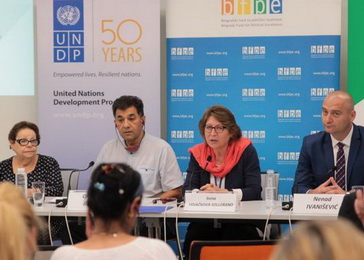 On July 13, the Resident UNDP Coordinator in Serbia Irena Vojackova-Sollorano estimated that the return of thousands of Roma persons from EU countries, once they have been denied asylum, and their reintegration into the Serbian society represent a heavy burden for the state system, and especially for the municipalities that are faced with unemployment, education, healthcare and social protection issues. The presentation of the pilot project entitled Reintegration of Roma Returnees in Serbia pointed to the need for strengthening of the social infrastructure in places where the number of people in readmission was the highest – in the South of Serbia. It was also stated that 75% of Roma youth did not see their future in Serbia.
On July 13, the Resident UNDP Coordinator in Serbia Irena Vojackova-Sollorano estimated that the return of thousands of Roma persons from EU countries, once they have been denied asylum, and their reintegration into the Serbian society represent a heavy burden for the state system, and especially for the municipalities that are faced with unemployment, education, healthcare and social protection issues. The presentation of the pilot project entitled Reintegration of Roma Returnees in Serbia pointed to the need for strengthening of the social infrastructure in places where the number of people in readmission was the highest – in the South of Serbia. It was also stated that 75% of Roma youth did not see their future in Serbia.
“The number of people that have to return is increasing. It is an unfortunate tendency that has been noticeable for years. Around 10.000 people return from Germany every year, plus 5.000 from other European countries. That is an enormous burden for the system and the municipalities”, Sollorano said during the meeting at which the pilot project entitled Reintegration of Roma Returnees in Serbia was presented.
The representative of the Belgrade Fund for Political Excellence, Sonja Liht said that the duty of the Serbian society and every individual was to help the Roma people – “the most vulnerable of all vulnerable groups” who had to find a home somewhere else because they didn’t have one in Serbia.
The State Secretary in the Ministry of Labour, Employment, Veteran and Social Affairs, Nenad Ivanišević, stated that the social infrastructure needed to be strengthened in places where the number of people in readmission was traditionally the highest, and that was in the South of Serbia.
The Roma Reintegration Project will be implemented in three municipalities – in Niš through economic empowerment, Subotica through education, and Odžaci through housing solutions.
Source: Beta, taken from www.euractiv.rs
 Government of the Republic of Serbia
Government of the Republic of Serbia















 pdf [271 KB]
pdf [271 KB]
Leave a Comment